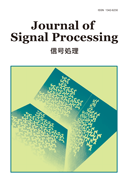
- Issue 6 Pages 257-
- Issue 5 Pages 197-
- Issue 4 Pages 99-
- Issue 3 Pages 77-
- Issue 2 Pages 37-
- Issue 1 Pages 1-
- |<
- <
- 1
- >
- >|
-
Kazuhiro Daikoku2024Volume 28Issue 5 Pages 197-221
Published: September 01, 2024
Released on J-STAGE: September 01, 2024
JOURNAL FREE ACCESSPrevious studies have revealed that both AGC (automatic gain control) and AFC/PLL (automatic frequency control/phase-locked loop) circuits for demodulating SSB/ISB (single sideband/independent sideband) modulated signals cannot cope with severe fading at all. The author therefore decided to develop an asynchronous demodulation scheme for SSB/ISB signals using a DSP processor, i.e. without AGC or AFC/PLL circuits. The adverse effects of fading on the amplitude and phase components of the received signal must be first removed at the receiver side. The introduction of the Hilbert transform has certainly enabled successful asynchronous demodulation. The paper presents asynchronous demodulation methods for three modulated signals such as RZ SSB (Real Zero SSB), multi-channel ISB and ISB-based AM (amplitude modulation) stereo signals propagating along a fading path. The demodulation circuit can be implemented in a feedforward configuration.
View full abstractDownload PDF (2629K) -
Kentaro Kimura, Toshiki Kuragasaki, Asuka Ohashi, Takakuni Douseki, Yo ...2024Volume 28Issue 5 Pages 223-232
Published: September 01, 2024
Released on J-STAGE: September 01, 2024
JOURNAL FREE ACCESSA semi-permanent two-dimensional (2D) code with ultra-small holes that can be embedded in various building materials and read with smartphones was developed. The code, called Porous code, is made of high-frequency cells of “1" data composed of shadows created from ultra-small holes corresponding to black cells in a Quick Response (QR) code and low-frequency cells of “0" data without holes, and thus no shadows, corresponding to white cells in a QR code. To read the code, it is first processed as follows: conversion to grayscale, detection of edges, binarization, morphological dilation and erosion, and smoothing of brightness. Since a conventional 2D code is obtained, it can be decoded using a conventional 2D code reader. We clarified the structure of “1" cells to achieve high reading accuracy through reading experiments involving Porous codes embedded in wooden and metal plates with various numbers of holes per “1" cell and hole depths. We succeeded in reading Porous codes under an illuminance of 12.5–7600 lux and verified that it is robust against illumination changes. In particular, Porous codes with four ultra-small holes in “1" cells were stably read the fastest under various illuminances. We also succeeded in reading Porous codes embedded in cement paste and marble under illuminances of 100 and 6090 lux.
View full abstractDownload PDF (5805K) -
Kentaro Kimura, Toshiki Kuragasaki, Takakuni Douseki, Yohei Fukumizu2024Volume 28Issue 5 Pages 233-247
Published: September 01, 2024
Released on J-STAGE: September 01, 2024
JOURNAL FREE ACCESSWe developed Porous code, an inconspicuous two-dimensional code with ultra-small holes by reducing the machining area, which can be semi-permanently embedded even into non-paper media. We clarified that the code can be read by using conventional 2D code readers when the machining area given by P/d is less than or equal to 1.3, where P and d denote the pitch and the diameter of the holes, respectively. However, Porous code cannot be read with conventional readers when P/d is greater than or equal to 1.4. Thus, we have also developed a smartphone reader for Porous code. In the reader algorithm, we demonstrated Porous code can be read by reconstructing all hole shapes from circles to squares using morphological erosion. To derive the relation between machining area and the number of erosion iterations, we embedded Porous codes with P/d of 1.5, 3.0, and 5.0 into a plastic plate. We found that decoding a Porous code whose P/d is less than or equal to 2.0 requires two times of erosion, while decoding a Porous code whose P/d is greater than 2.0 requires needs three times. We verified that Porous codes are generally applicable to 2D codes as the reading accuracy is sufficient for both QR-based and Data matrix-based codes. We also successfully demonstrated practicality through reading experiments on a Porous code with d of 100 µm and P of 180µm, which is embedded into the inner side of a leather coin purse and can be read stably at a high speed.
View full abstractDownload PDF (12620K) -
33. Hypothetic Mathematical Definitions Setting on Unit Elements Derived from Coaxial CablesNobuo Nagai, Hirofumi Sanada, Takashi Yahagi2024Volume 28Issue 5 Pages 249-255
Published: September 01, 2024
Released on J-STAGE: September 01, 2024
JOURNAL FREE ACCESSHeaviside proposed the telegrapher's equations as an alternative to the Maxwell equations. The telegrapher's equations demonstrated that the electromagnetic waves propagate in coaxial cables at the velocity of light c. The electromagnetic waves are used in Fourier analysis, Laplace transformation, and z transformation. Electromagnetic waves exhibit the physical phenomenon of simultaneous “partial reflection and refraction”. Feynman found it tremendously important from the viewpoint of the physical phenomenon and advanced to the studies of quantum electrodynamics and quantum mechanics. In this session, we demonstrate that the physical phenomenon of partial reflection and refraction is an expression of the “law of conservation of energy” of electromagnetic waves, which falls into the category of classical physics.
View full abstractDownload PDF (947K)
- |<
- <
- 1
- >
- >|